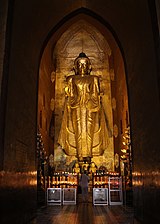Ananda temple

The Ananda Temple (No. 2171) is a Buddhist temple in Bagan in northern Myanmar , which was built from 1091 to 1105 during the reign of King Kyanzittha . It is one of the eleven largest structures in Bagan.
location
The temple is located about 200 meters east of the city walls of the old city of Bagan.
description
The name of the temple is reminiscent of the long-time companion and cousin of the Buddha , Ananda . The building is an example of Indian architecture .
The plan of the temple has a cross shape; many levels lead to the apex, which is formed by a Shikhara and a screen ( Hti ). On the outer walls there are 1472 glazed tiles with terracotta reliefs depicting scenes from the Jataka . The last ten Jataka are told in the language of the Mon on the 400 tiles on the upper terraces . There are 537 tiles on the balustrade of the superstructure, on which other Jataka are depicted and explained in Pali . Scenes from the life of Siddhartha Gautama are depicted on reliefs on the base of the building . They are also commented in the Mon language. The interior walls of the temple were decorated with murals, fragments of which were discovered during restoration work in the 1960s.
On each side of the massive pillar in the middle there are niches in which there are four standing Buddha statues that are twelve meters high and covered with gold leaf and look in the four cardinal directions. They each represent one of the last four Buddhas: Kakusanda in the north, Konagama in the east, Kashyapa in the south and Gautama in the west. The latter is flanked by two portrait statues: that of the client, King Kyanzittha, and that of a theorist of Burmese Buddhism by the name of Shin Arahan. There is also a marble footprint of the Buddha in the western entrance hall .
There are annual festivities in the temple that last a week in December or January. Thousands of villagers move here during this time and offer gifts for the monks present on the morning of the full moon day.
In 1795 the temple was renovated by King Bodawpaya . In 1975 it was damaged in an earthquake. For the 900th anniversary in 1991, the five Shikhara towers on the roof of the temple were gilded, the other walls freshly whitewashed.
gallery
Individual evidence
- ↑ Oshegowa: Art in Burma. 1988, p. 61.
- ^ Charles FW Higham : Encyclopedia of Ancient Asian Civilizations. Facts on File, New York NY 2004, ISBN 0-8160-4640-9 .
- ↑ Oshegowa: Art in Burma. 1988, p. 65.
- ↑ Oshegowa: Art in Burma. 1988, p. 62.
- ^ Henry Burney : Notice of Pugan, the ancient capital of the Burmese Empire. In: Journal of the Asiatic Society of Bengal. Vol. 4, 1835, pp. 400-404 .
literature
- Pictorial Guide to Pagan. Ministry of Culture, Rangoon 1975 [1955].
- Nina Oshegowa, Sergej Oshegow: Art in Burma. 2000 years of architecture, painting and sculpture under the sign of Buddhism and animism. VEB EA Seemann, Leipzig 1988, ISBN 3-363-00054-5 .
- Paul Strachan: Pagan. Art & Architecture of Old Burma. 2nd UK edition. Kiscadale Publications, Oxford 1996, ISBN 1-870838-85-8 , pp. 65-71.
Web links
Coordinates: 21 ° 10 ′ 18 ″ N , 94 ° 52 ′ 0 ″ E











